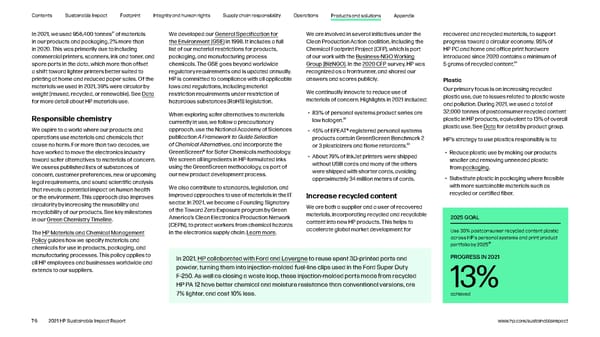Contents Sustainable Impact Footprint Integrity and human rights Supply chain responsibility Operations Products and solutions Appendix 31 In 2021, we used 956,400 tonnes of materials We developed our General Specification for We are involved in several initiatives under the recovered and recycled materials, to support in our products and packaging, 2% more than the Environment (GSE) in 1998. It includes a full Clean Production Action coalition, including the progress toward a circular economy. 95% of in 2020. This was primarily due to including list of our material restrictions for products, Chemical Footprint Project (CFP), which is part HP PC and home and office print hardware commercial printers, scanners, ink and toner, and packaging, and manufacturing process of our work with the Business-NGO Working introduced since 2020 contains a minimum of spare parts in the data, which more than offset chemicals. The GSE goes beyond worldwide Group (BizNGO). In the 2020 CFP survey, HP was 34 5 grams of recycled content. a shift toward lighter printers better suited to regulatory requirements and is updated annually. recognized as a frontrunner, and shared our printing at home and reduced paper sales. Of the HP is committed to compliance with all applicable answers and scores publicly. Plastic materials we used in 2021, 39% were circular by laws and regulations, including material Our primary focus is on increasing recycled weight (reused, recycled, or renewable). See Data restriction requirements under restriction of We continually innovate to reduce use of plastic use, due to issues related to plastic waste for more detail about HP materials use. hazardous substances (RoHS) legislation. materials of concern. Highlights in 2021 included: and pollution. During 2021, we used a total of When exploring safer alternatives to materials • 83% of personal systems product series are 32,000 tonnes of postconsumer recycled content Responsible chemistry 32 plastic in HP products, equivalent to 13% of overall currently in use, we follow a precautionary low halogen. We aspire to a world where our products and approach, use the National Academy of Sciences • 45% of EPEAT®-registered personal systems plastic use. See Data for detail by product group. operations use materials and chemicals that publication A Framework to Guide Selection products contain GreenScreen Benchmark 2 HP’s strategy to use plastics responsibly is to: cause no harm. For more than two decades, we of Chemical Alternatives, and incorporate the 33 or 3 plasticizers and flame retardants. have worked to move the electronics industry GreenScreen® for Safer Chemicals methodology. • About 79% of InkJet printers were shipped • Reduce plastic use by making our products toward safer alternatives to materials of concern. We screen all ingredients in HP-formulated inks without USB cords and many of the others smaller and removing unneeded plastic We assess published lists of substances of using the GreenScreen methodology, as part of were shipped with shorter cords, avoiding from packaging. concern, customer preferences, new or upcoming our new product development process. approximately 34 million meters of cords. • Substitute plastic in packaging where feasible legal requirements, and sound scientific analysis with more sustainable materials such as that reveals a potential impact on human health We also contribute to standards, legislation, and or the environment. This approach also improves improved approaches to use of materials in the IT Increase recycled content recycled or certified fiber. circularity by increasing the reusability and sector. In 2021, we became a Founding Signatory We are both a supplier and a user of recovered recyclability of our products. See key milestones of the Toward Zero Exposure program by Green materials, incorporating recycled and recyclable in our Green Chemistry Timeline. America’s Clean Electronics Production Network content into new HP products. This helps to 2025 GOAL (CEPN), to protect workers from chemical hazards accelerate global market development for The HP Materials and Chemical Management in the electronics supply chain. Learn more. Use 30% postconsumer recycled content plastic Policy guides how we specify materials and across HP’s personal systems and print product portfolio by 202535 chemicals for use in products, packaging, and manufacturing processes. This policy applies to In 2021, HP collaborated with Ford and Lavergne to reuse spent 3D-printed parts and PROGRESS IN 2021 all HP employees and businesses worldwide and powder, turning them into injection-molded fuel-line clips used in the Ford Super Duty extends to our suppliers. F-250. As well as closing a waste loop, these injection-molded parts made from recycled HP PA 12 have better chemical and moisture resistance than conventional versions, are 13% 7% lighter, and cost 10% less. achieved 76 2021 HP Sustainable Impact Report www.hp.com/sustainableimpact
 HP Sustainable Impact Report Page 75 Page 77
HP Sustainable Impact Report Page 75 Page 77